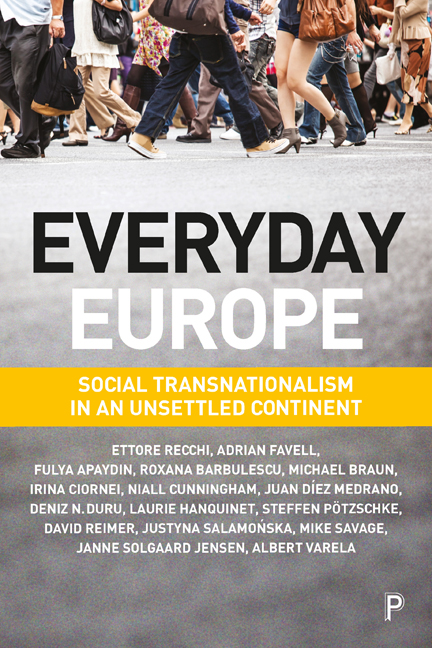Book contents
- Frontmatter
- Contents
- List of tables and figures
- Notes on contributors
- Acknowledgements
- Introduction: Social transnationalism in an unsettled continent
- one Cartographies of social transnationalism
- two The social structure of transnational practices
- three Cultural boundaries and transnational consumption patterns
- four Social transnationalism and supranational identifications
- five Explaining supranational solidarity
- six Narratives and varieties of everyday transnationalism
- seven Understanding Romanians’ cross-border mobility in Europe: movers, stayers and returnees
- eight Transnational Turkey: the everyday transnationalism and diversity of Turkish populations in Europe
- Epilogue Is social transnationalism fusing European societies into one?
- Methodological appendix
- Index
seven - Understanding Romanians’ cross-border mobility in Europe: movers, stayers and returnees
Published online by Cambridge University Press: 19 April 2022
- Frontmatter
- Contents
- List of tables and figures
- Notes on contributors
- Acknowledgements
- Introduction: Social transnationalism in an unsettled continent
- one Cartographies of social transnationalism
- two The social structure of transnational practices
- three Cultural boundaries and transnational consumption patterns
- four Social transnationalism and supranational identifications
- five Explaining supranational solidarity
- six Narratives and varieties of everyday transnationalism
- seven Understanding Romanians’ cross-border mobility in Europe: movers, stayers and returnees
- eight Transnational Turkey: the everyday transnationalism and diversity of Turkish populations in Europe
- Epilogue Is social transnationalism fusing European societies into one?
- Methodological appendix
- Index
Summary
Mobility practices of Romanian stayers, movers and returnees
Decades of prohibition to leave the country during the communist era and a defective double transition to democracy and the free market have turned Romanians into one of the most mobile populations in Europe. For Romanians as well as for Central Europeans who faced the same transitions, the ability to travel as well as to settle abroad is a newfound freedom. While all Romanians have gained more mobility, many move to another European country for longer periods. There are estimates of almost 7 million Central and Eastern Europeans registered as living in another EU country (Black et al 2010; Glorious et al 2013; Barbulescu et al 2015), who have followed in the footsteps of the intra-EU mobile citizens of Western Europe (Favell 2008a; Recchi and Favell 2009). Almost half of these 7 million are Romanian citizens, who constitute the largest nationality among intra-EU migrants. The great majority of them have moved abroad over the last two decades, once they gained the freedom to travel. In particular, outward mobility accelerated after 2007 when Romania joined the EU and many constraints to travel were removed.
The migration of literally millions of Romanians has been generally perceived as labour migration. Not surprisingly, studies of this topic amount today to a small library (Barbulescu 2009; Boswell and Ciobanu 2009; Anghel 2013; Morseanu 2013a and 2013b; Ciornei 2014 and 2015; Croitoru et al 2014; Moreh 2014; McMahon 2015; Ciobanu 2015; Nedelcu and Wyss 2016). However, the focus on flows of migrants shadows the mobility of Romanians who do not move abroad or the mobility of Romanians who return but who nonetheless move freely, often and widely across borders in Europe. Some efforts have indeed been made to recalibrate ‘Romanian migration’ to include other forms of mobility including return or seasonal mobility. For example, Engbersen and colleagues (2010; 2014) argue that the mobility of Central and Eastern Europeans more generally is bidirectional, unstable or footloose and can be referred to as ‘liquid migration’. Others, such as Favell (2008b), have urged a rethink of conceptions of migration in order to integrate the newer East–West European mobilities to the theory of migration and mobility.
- Type
- Chapter
- Information
- Everyday EuropeSocial Transnationalism in an Unsettled Continent, pp. 195 - 224Publisher: Bristol University PressPrint publication year: 2019

